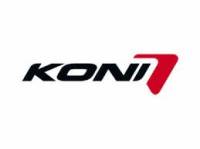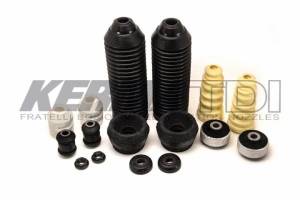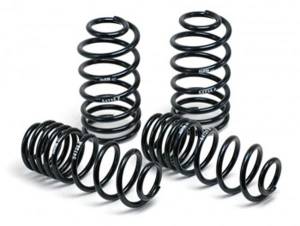Koni Sport [Yellow] Strut and Shock Set (MK4)
Description
Set of 4 Koni Yellow Sport Dampers for all FWD MK4 VW/Audi (Golf/Jetta/Beetle/TT, R32 and AWD TT
Consists of
2 x 8710-1337Sport Front Struts
2 x Sedan (80-2761Sport) or Wagon (80-2815Sport) Rear Shocks
Interested in Suspension Installation Kit. CLICK HERE
Q: What is the difference between KONI Special (red) and KONI Sport (yellow)?
A: The KONI Special (red) has been engineered to maximize ride comfort with good handling performance for each vehicle application. The KONI Sport (yellow) typically starts at a higher initial valving baseline to give a sportier feel and work on vehicles with higher performance parts. Sometimes, KONI only offers a Special or Sport valving, not both. Some modern cars come from the factory with higher tech suspension systems and wheel/tire packages, so they would move directly into the Sport range. However, they are still valved to give a comfortable ride with very good handling capabilities.
Q: How much stiffer are KONIs than factory shocks?
A: This is a difficult question to answer because every KONI application is developed for that specific vehicle to get the best handling characteristics. Generally, most factory shocks are underdamped for optimized handling, so KONI engineers select firmer valving. Unfortunately, factory shocks are generally chosen for financial reasons rather than performance, so lower technology, cheaper shocks are standard. In some instances, a factory shock may have good characteristics in some parts of the working range but need some help in other parts. There are even a few instances where the KONI engineers found better handling by softening the factory units.
Q: What is the best adjustment setting for my shocks?
A: There is no single best adjustment setting for your KONIs because every driver has different preferences for comfort, performance, performance modifications, and roads to drive on. We suggest that new KONIs be installed in the full soft position for most vehicles. (the standard setting right out of the box) to take advantage of the balance of ride comfort and handling designed by the KONI ride development engineers. If the car has performance upgrades (springs, wheel/tire packages, etc.) or the driver wants the car a bit more aggressive, most people find the optimum setting in the 1/2 to one full turn from the full soft range. Over the extended life of the damper or if the driver wants a specific firm handling characteristic, the dampers can be adjusted up higher. Very rarely will KONI need to adjust to the full firm setting.
Q: What are the best springs to match my KONIs.
A: One of the great advantages of KONI adjustable shocks is that there is no specific spring for matching optimum performance. Instead, you can adjust your KONIs to match your springs. Most performance springs have a higher spring rate than the vehicle's original springs. Since the shock controls the motion of the spring, increased spring rates require more rebound damping for control, which is one reason why KONIs are rebound adjustable (and some are double adjustable). Higher-rate springs with OE or soft shocks will quickly overcome and wear out the shocks. The KONI adjustment range is typically about 100% (twice as firm at the full firm settings at the full soft setting) to allow for proper damping of OE springs and high rate performance springs.
Q: How far can I safely lower my car?
A: KONIs are designed to fit standard height cars and can work with lowered cars as long as they don't bottom out internally and become damaged. Unlike some shocks, KONIs are not position sensitive so they will work properly anywhere in their stroke range providing they are not bottoming or topping out. Different vehicle suspension designs have different stroke travels, but a good rule of thumb is that most vehicles can be lowered acceptably about 1 1/2 inches; beyond that, the possibility of bottoming increases rapidly, although some longer stroke cars can go lower. Most vehicles are equipped with bump stops to keep the shocks and springs from bottoming out. When lowering a vehicle, reuse your bump stops as they are cheap insurance to avoid bottoming damage. Remember also that severely lowered vehicles typically also have a negative effect on suspension geometry, ride quality and handling, and tire and suspension part wear.
Q: KONI makes some shocks that are not gas shocks. Why?
A: There are basically three types of shock absorber designs: mono-tube high-pressure gas, twin-tube low-pressure gas, and twin-tube hydraulic (non-gas). Each of these designs has a certain ride and performance characteristic that can enhance the performance of a vehicle, and KONI is the only company that has made three designs. KONI ride development engineers evaluate each new vehicle and can decide which shock design would best apply to that vehicle. Some cars respond to monotubes, some like gas pressure, and others don't. Most shock companies utilize only one or two of these styles because it is less expensive for manufacturing but are therefore limited in design capability and function.
Q: I want to lower my car with a coil-over sleeve kit. How do I setup my vehicle with KONIs and coil-over sleeves?
A: There are many coil-over sleeve systems on the market, but the key is to find ones that will fit the KONI damper properly. Most of these are built to fit over many aftermarket shock absorber brands, but this means many will not fit well. KONI is unique because some applications feature an adjustable spring seat mounted on a circlip on the shock body. This circlip design is extremely strong when loaded properly and captured so that it cannot be forced open. However, if the mounting on the circlip is unevenly loaded or not properly captured, allowing the circlip to increase in diameter from load or impact, you have a potentially dangerous situation where damage could occur. With proper installation and loading, the circlip system allows for great strength and ride height adjustability at the same time. Additionally, when selecting and installing your coil-over system, care should be taken to avoid allowing the springs to coil bind (compressing the spring down to a solid state) during usage as this can risk bottoming and damage. A proper length bump rubber should be used to keep the spring from coil binding and the shocks from bottoming internally. You should contact the dealer or the manufacturer of the coil-over system and get any necessary adapter rings necessary to mount the sleeve system to the KONI.
Q: Why are some KONI shocks not externally adjustable?
A: Whenever possible, we try to have the application be externally adjustable so that they can be easily adjusted on the car. In some cases, this is not possible due to the vehicle's design constraints. Some cars have no way to access an adjuster on the car physically or have mounts that prohibit an adjustable shock. In these cases, the shocks are still adjustable but must be removed from the car to do so.
Q: What's the difference between the standard KONI shocks and those in the Threaded Suspension Kits and the RSK kits?
A: The dampers in Threaded Suspension Kits are based on KONI Sport shocks but have been made specifically for the elements of the kits. Depending on the applications, some have different maximum or minimum lengths and valvings to match the springs and lowering goals of the kits specifically. Most are plated and threaded bodies and some are tight steel sleeves on yellow painted shock bodies. The dampers in the RSK kits are based on the red painted KONI Special shocks but they have been specifically valved to work with the kit springs. Additionally, they have multiple spring perch grooves, so the height of the car can be adjusted at the time of installation.
Q: What is the KONI warranty? How do I go about getting replacements?
A: The KONI warranty is a lifetime warranty to the original purchaser against defects in materials and workmanship for as long as you own that car registered for street use. The warranty does not cover damage to the parts caused by misuse, misapplication, installation, motorsports, etc. The warranty does not include mounting bushings. If you have a defective damper, you can contact the company from which you purchased the unit(s) or KONI North America directly at warranty@koni-na.com or 859-586-4100. We will require a copy of the purchase receipt and a vehicle registration to process your warranty. We will generate a return goods authorization (RGA) and can replace the dampers in advance at your discretion. For more specific information about the warranty, please see our warranty form.
Q: I own a vehicle with sealed struts, yet you offer an insert for it. How is this possible?
A: KONI has designed an ingenious method of installing inserts into sealed housings thus allowing the use of performance dampers when they were previously unavailable. It has become common practice for auto manufacturers worldwide to save money by using factory sealed strut housings rather than the traditional threaded closed housings when they build new cars. KONI will make a complete strut housing damper whenever possible, but sometimes the necessary spring perches and mounting brackets are unavailable or financially unfeasible to produce. By designing the KONI Cut-A-Strut insert system, many vehicles with factory sealed struts now have performance damper options. The installation requires only basic tools that most individuals already own. These tools include a cutting device such as a hacksaw, grinder, or pipe cutter to open the strut housing and an electric drill. Generally, it takes an average of 15-20 minutes of additional labor per corner over a traditional strut insert installation. KONI has used this method successfully for many years in numerous applications, from Porsche to Ford, Honda to Hyundai. If you have any questions, please feel free to contact KONI, your dealer, or click here for additional instructions.
Q: I often hear the terms strut and shock used interchangeably. Are they different?
A: Shocks and struts are similar in that they damp (slow down) the vehicle motion. The key difference between a strut vs. a shock is that a shock only controls the motion of the car while a strut is a locating member of the suspension. This means that if you remove a shock the spindle or axle will still be completely attached to the vehicle. If you remove a strut the spindle or axle will be able to move outside of its normal motion. Shocks and struts may or may not have a spring mounted to them either. It is often assumed that any damper with a spring is a strut, this is not the case.
Reviews / Q&A
Details
- KoniYellowMK4
- KoniYellowMK4
- Koni
- New
Categories
Shipping Information
- Item Requires Shipping
- 38.0 lbs.
- W24.0000” x H12.0000” x L8.0000”
- Free Ground or Postal Service Shipping to the Continental U.S.


![Koni - Koni Sport [Yellow] Strut and Shock Set (MK4)](https://kermatdi.com/images/M3024.jpg)


